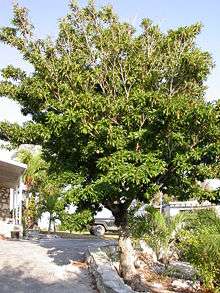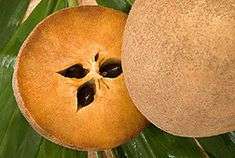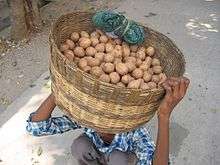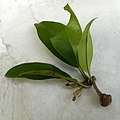Manilkara zapota
Manilkara zapota, commonly known as sapodilla (/ˌsæpəˈdɪlə/), sapota, chikoo, naseberry, or nispero[1] is a long-lived, evergreen tree native to southern Mexico, Central America and the Caribbean.[2] An example natural occurrence is in coastal Yucatán in the Petenes mangroves ecoregion, where it is a subdominant plant species.[3] It was introduced to the Philippines during Spanish colonization. It is grown in large quantities in India, Pakistan, Thailand, Malaysia, Cambodia, Indonesia, Vietnam, Bangladesh and Mexico.
The name "zapota" from the Spanish zapote [θaˈpote] ultimately derives from the Nahuatl word tzapotl.
Description

Sapodilla can grow to more than 30 m (98 ft) tall with an average trunk diameter of 1.5 m (4.9 ft). The average height of cultivated specimens, however, is usually between 9 and 15 m (30 and 49 ft) with a trunk diameter not exceeding 50 cm (20 in).[4] It is wind-resistant and the bark is rich in a white, gummy latex called chicle. The ornamental leaves are medium green and glossy. They are alternate, elliptic to ovate, 7–15 cm (2.8–5.9 in) long, with an entire margin. The white flowers are inconspicuous and bell-like, with a six-lobed corolla. An unripe fruit has a firm outer skin and when picked, releases white chicle from its stem. A fully ripened fruit has saggy skin and does not release chicle when picked.
The fruit is a large berry, 4–8 cm (1.6–3.1 in) in diameter.[5][6] Inside, its flesh ranges from a pale yellow to an earthy brown color with a grainy texture akin to that of a well-ripened pear. Each fruit contains one to six seeds.[6] The seeds are hard, glossy, and black, resembling beans, with a hook at one end that can catch in the throat if swallowed.
The fruit has an exceptionally sweet, malty flavor. The unripe fruit is hard to the touch and contains high amounts of saponin, which has astringent properties similar to tannin, drying out the mouth.
The trees can survive only in warm, typically tropical environments, dying easily if the temperature drops below freezing. From germination, the sapodilla tree will usually take anywhere from five to eight years to bear fruit. The sapodilla trees yield fruit twice a year, though flowering may continue year round.
Other names
Sapodilla is known as mispel in the Virgin Islands[1] and Dutch Caribbean; zapote in Honduras and Panama; níspero in Dominican Republic, El Salvador, Costa Rica, Cuba, Guyana, Puerto Rico, Nicaragua, Colombia and Venezuela; dilly in the Bahamas; naseberry in Jamaica and other parts of the Caribbean; sapoti in Brazil (Portuguese pronunciation: [sɐpuˈtʃi]) and Haiti; chico in the Philippines and chicosapote or chicozapote in Guatemala, Mexico, Hawaii, and Florida.[7][8]
It is known as chikoo (chiku, "चीकू") in Northern India, Pakistan ("چیکو" chiku and "ਚੀਕੂ" in Punjab) and the Philippines (chico), sapota in South Indian languages ("சப்போட்டா" or "சீமை இலுப்பை" in Tamil, "ಸಪೋಟ" in Kannada, "సపోటా" in Telugu, "സപ്പോട്ട " in Malayalam), sapeta "ସପେଟା" in Odia and sapathilla or rata-mi in Sri Lanka, sobeda/sofeda (সবেদা or সফেদা) in eastern India and Bangladesh, sabudheli ("ސަބުދެލި") in Maldives; sawo in Indonesia and saos in the province of West Sumatra; hồng xiêm (lit. Siamese persimmon), lồng mứt, or xa pô chê in Vietnam; lamoot (ละมุด) in Thailand, Laos and (ល្មុត) in Cambodia.
It is called ciku (pronounced chiku) in standard Malay, and sawo nilo in Kelantanese Malay. In Chinese, the name is mistakenly translated by many people roughly as "ginseng fruit" (人參果), though this is also the name used for the pepino, an unrelated fruit; it should instead be "heart fruit" (人心果) because it is shaped like the heart.
Biological studies
Compounds extracted from the leaves showed anti-diabetic, antioxidant and hypocholesterolemic (cholesterol-lowering) effects in rats.[9]
Acetone extracts of the seeds exhibited in vitro antibacterial effects against strains of Pseudomonas oleovorans and Vibrio cholerae.[10]
Synonyms
Synonyms of this species include:[11]
- Achradelpha mammosa (L.) O.F.Cook
- Achras breviloba (Gilly) Lundell
- Achras calderonii (Gilly) Lundell
- Achras conzattii (Gilly) Lundell
- Achras coriacea Lundell
- Achras dactylina Lundell
- Achras gaumeri (Gilly) Lundell
- Achras latiloba Lundell
- Achras lobulata (Lundell) Lundell
- Achras lucuma Blanco
- Achras mammosa L. nom. illeg.
- Achras meridionalis (Gilly) Lundell
- Achras occidentalis Cels ex Ten.
- Achras paludosa Lundell
- Achras petenensis (Lundell) Lundell
- Achras rojasii (Gilly) Lundell
- Achras sapatilla J.Paul & W.Arnold
- Achras sapota L. [Spelling variant]
- Achras striata (Gilly) Lundell
- Achras tabogaensis (Gilly) Lundell
- Achras tainteriana Lundell
- Achras tchicomame Perr.
- Achras verrucosa Stokes
- Achras zapota L.
- Achras zapotilla (Jacq.) Nutt.
- Calocarpum mammosum (L.) Pierre
- Calospermum mammosum (L.) Pierre
- Gambeya mammosa (L.) Pierre
- Lucuma mammosa (L.) C.F.Gaertn.
- Lucuma zapota (L.) Urb.
- Manilkara achras (Mill.) Fosberg
- Manilkara breviloba Gilly
- Manilkara calderonii Gilly
- Manilkara conzattii Gilly
- Manilkara gaumeri Gilly
- Manilkara grisebachii (Pierre) Dubard
- Manilkara meridionalis Gilly
- Manilkara rojasii Gilly
- Manilkara striata Gilly
- Manilkara tabogaensis Gilly
- Manilkara zapotilla (Jacq.) Gilly
- Manilkariopsis lobulata Lundell
- Manilkariopsis meridionalis (Gilly) Lundell
- Manilkariopsis petenensis Lundell
- Manilkariopsis rojasii (Gilly) Lundell
- Manilkariopsis striata (Gilly) Lundell
- Manilkariopsis tabogaensis (Gilly) Lundell
- Mimusops grisebachii Pierre
- Nispero achras (Mill.) Aubrév.
- Pouteria mammosa (L.) Cronquist
- Sapota achras Mill.
- Sapota zapotilla (Jacq.) Coville ex Safford
- Vitellaria mammosa (L.) Radlk.
Uses
The fruit is edible and a favorite in the American Tropics.[12]
See also
References
| Wikimedia Commons has media related to Manilkara zapota. |
| Wikispecies has information related to Manilkara zapota |
- Morton, J. (1987). "Sapodilla". In Julia F. Morton (ed.). Fruits of Warm Climates. Florida Flair Books, Miami, FL. pp. 393–398.
- "Manilkara zapota". Germplasm Resources Information Network (GRIN). Agricultural Research Service (ARS), United States Department of Agriculture (USDA). Retrieved 2010-04-30.
- World Wildlife Fund. eds. Mark McGinley, C.Michael Hogan & C. Cleveland. 2010. Petenes mangroves. Encyclopedia of Earth. National Council for Science and the Environment. Washington DC Archived 2011-10-15 at the Wayback Machine
- Manilkara zapota Sapotaceae (L.) van Royen, Orwa C, Mutua A, Kindt R, Jamnadass R, Simons A. 2009. Agroforestree Database:a tree reference and selection guide version 4.0 (http://www.worldagroforestry.org/af/treedb/)
- Flora of North America, 8
- Harris, Kate (2009). Trees of Belize. Belize: Bay Cedar Publishing. pp. 94–95. ISBN 9780992758202.
- "Sapodilla Fruit Facts", California Rare Fruit Growers. Retrieved on 2009/03/26
- "Ten Tropical Fruits of Potential Value for Crop Diversification in Hawaii", College of Tropical Agriculture and Human Resources. Retrieved on 2009/03/26
- Fayek NM, Monem AR, Mossa MY, Meselhy MR, Shazly AH (2012). "Chemical and biological study of Manilkara zapota (L.) Van Royen leaves (Sapotaceae) cultivated in Egypt". Pharmacognosy Research. 4 (2): 85–91. doi:10.4103/0974-8490.94723. PMC 3326762. PMID 22518080.
- Kothari V, Seshadri S (2010). "In vitro antibacterial activity in seed extracts of Manilkara zapota, Anona squamosa, and Tamarindus indica". Biol. Res. 43 (2): 165–8. doi:10.4067/S0716-97602010000200003. PMID 21031260.
- The Plant List: A Working List of All Plant Species, retrieved 18 October 2015
- Hargreaves, Dorothy; Hargreaves, Bob (1964). Tropical Trees of Hawaii. Kailua, Hawaii: Hargreaves. p. 14.







